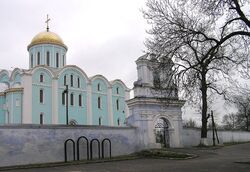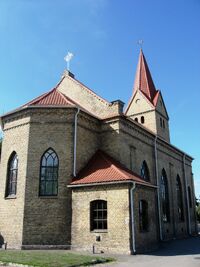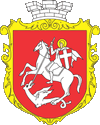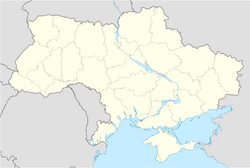| Main | Births etc |
|---|
| Vladimir-Volynsky Володимир-Волинський Владимир-Волынский |
|||
|---|---|---|---|
| — City — | |||
|
|||
| Coordinates: Coordinates: | |||
| Country Oblast Rayon |
Volodymyr-Volynskyi Rayon |
||
| Founded | 10th Century | ||
| Government | |||
| • Mayor | Peter Shanyk | ||
| Area | |||
| • Total | 16.47 km2 (6.36 sq mi) | ||
| Elevation | 174 m (571 ft) | ||
| Population | |||
| • Total | 38,662 | ||
| • Density | 4,830/km2 (12,500/sq mi) | ||
| Population | |||
| Time zone | EET (UTC+3) | ||
| • Summer (DST) | EEST (UTC+3) | ||
| Postal code(s) | 44700-44709 | ||
| Area code(s) | +380 3342 | ||
| Sister cities | Kętrzyn Poland | ||
| Website | http://www.volodymyrrada.gov.ua/ | ||
Vladimir-Volynsky or Volodymyr-Volynskyi (Ukrainian: Володимир-Волинський|, Russian: Владимир-Волынский, Latin: Lodomeria, Polish: Włodzimierz) is a city located in Volyn Oblast, in north-western Ukraine. Serving as the administrative centre of the Volodymyr-Volynskyi Rayon, the city itself being designated as a separate rayon within the oblast. The city is the historic centre of the region of Volhynia and the historic capital of the Principality of Volhynia.
The mediaeval Latin name of the town became the namesake of the 19th century Austro-Hungarian Kingdom of Galicia and Lodomeria, of which the town itself was not a part. The current estimated population is around 38,000 (as of 2004). 5 km south from Volodymyr is Zymne, where the oldest Orthodox monastery in Volynia is located.
History[]

Assumption Cathedral: built by Mstislav Isyaslavich in 1160, collapsed in 1829, restored in 1896-1900
The city is one of the oldest towns in Ruthenia. It was most likely founded in the second half of 10th century; the first documented mention of its name dates back to 988. Early on it became the capital of a separate principality and a seat of an Orthodox bishopric. By 13th century it became part of Galicia–Volhynia as one of the most important trading towns in the region. In the 14th century, Metropolitan Theognostus of all Rus' resided in the city for several years before moving to Moscow.[1]
In 1349 King Casimir the Great of Poland captured the city, and subsequently it remained in Kingdom of Poland's sphere of influence. However, in 1370 it was taken by the Grand Duchy of Lithuania and it was not until the Union of Lublin of 1569 that it returned to be a part of the Crown of Poland. In the meantime the city received Magdeburg Rights in 1431. On July 17, 1792 a battle (the Battle of Włodzimierz) took place in the vicinity of the town: a numerically inferior Polish force led by Tadeusz Kościuszko defeated the Russian army. The city remained a part of Poland until the Partitions of 1793, when the Russian Empire annexed it.
In 18th and 19th centuries the town started to grow rapidly, mostly thanks to large numbers of Jews settling there. By the second half of 19th century they made up the majority of local inhabitants. According to Geographical Dictionary of the Kingdom of Poland[2] in late 19th century the city had 8336 inhabitants, 6122 of them Jews.
Immediately after World War I the area became disputed by Poland, Bolshevist Russia and Ukrainian People's Republic, with the Polish 17th Infantry Regiment capturing it overnight of January 23, 1919. In the interbellum the city was a seat of a powiat within the Volhynian Voivodeship and an important garrison was located there. Following the Nazi-Soviet Pact the city was seized by Soviet forces in 1939, and then in 1941 it was seized by Germany. During World War II, a German concentration camp was located near the city. In the course of World War II it was ultimately captured by the Red Army and annexed to the Ukrainian SSR. A Cold War air base was located northeast of the town at Khovtnevoy. Since 1991 the city has formed part of Ukraine.
Churches in Volodymyr-Volynskyi[]
The oldest place of worship in the town was the so-called Khram of Vladimir, erected several kilometres from the modern town's centre and first mentioned in a latopis of 1044. The oldest existing church is the Assumption Cathedral built by Mstislav Isyaslavich in 1160. By late 18th century it fell into disuse and finally collapsed in 1829, but was restored between 1896 and 1900. The third of the old Orthodox churches is an Orthodox Basil the Great's cathedral, was erected probably in 14th or 15th centuries, though local legends attribute its construction to Vladimir the Great who was to build it some time after 992.

Greek-Catholic Church (formerly Lutheran)
In 1497 duke Alexander Jagiellon erected a Catholic church of Holy Trinity and a Dominican monastery. In 1554 another wooden Catholic church was founded by Princess Anna Zbaraska, which was later replaced by a new St. Joahim's and Anna's church in 1836. In 1755 a Jesuit church was erected there by the starost of Słonim Ignacy Sadowski and in 1780 a Greek Catholic Josaphat's church was added to the list. Following Russian Empire's takeover of the town in the effect of the Partitions of Poland, both latter shrines were confiscated and donated to the authorities of the Orthodox Church, who converted them to an Orthodox monastery and church, respectively, while the Dominican monastery was converted to an administrative building.
International relations[]
Twin towns — Sister cities[]
Volodymyr-Volynskyi is twinned with:
References[]
- ^ Meyendorff, John. Byzantium and the Rise of Russia, p.84.
- ^ (Polish) various authors (1880). "Włodzimierz". In Filip Sulimierski, Bronisław Chlebowski, Władysław Walewski. Geographical Dictionary of the Kingdom of Poland. XIV. Warsaw: Wiek. pp. 169–170. http://dir.icm.edu.pl/pl/Slownik_geograficzny/Tom_XIV/169.
| |||||||||||||||||||||||
| |||||||||||||||||||||||||||||||||||


